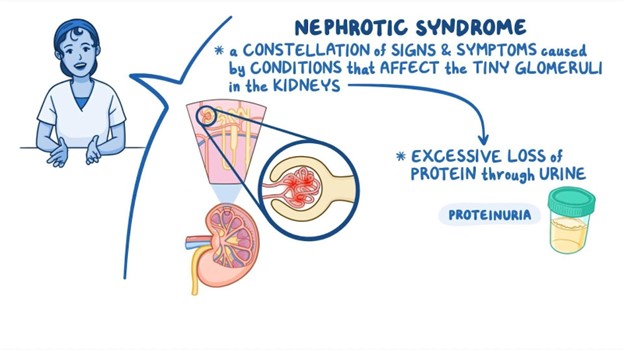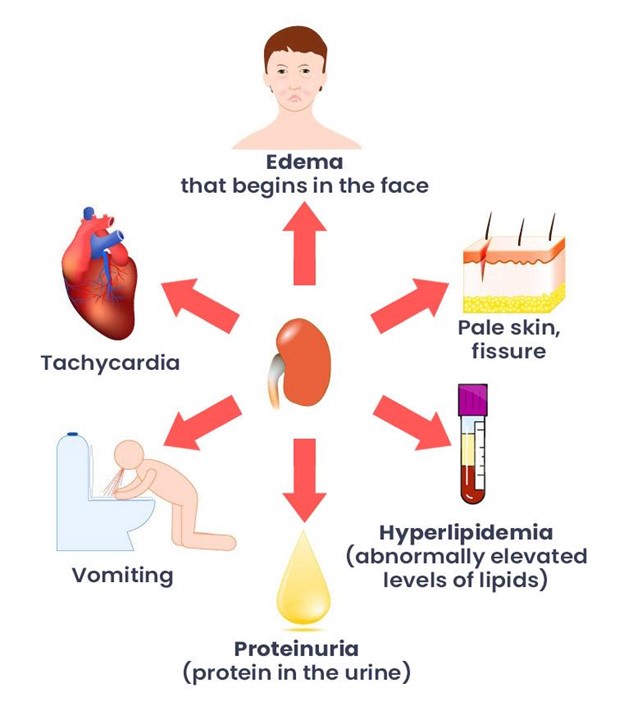A 4-year-old with nephrotic syndrome is experiencing severe periorbital edema. The best measure the nurse could institute to help reduce the periorbital edema is:
apply cool sterile soaks to the child's head
apply warm compresses
encourages the child to eat low protein foods
elevate the head of the bed
The Correct Answer is B
A. Apply cool sterile soaks to the child's head.
Explanation: Applying cool sterile soaks to the child's head would not directly address periorbital edema. Nephrotic syndrome is a kidney disorder that results in proteinuria (loss of protein in urine), leading to fluid accumulation and edema. Cooling the head would not have a significant impact on reducing periorbital edema caused by nephrotic syndrome.
B. Apply warm compresses.
Explanation: Correct Choice. Applying warm compresses can help increase blood circulation and promote the reabsorption of excess fluid causing periorbital edema. Warmth can dilate blood vessels and improve the movement of fluids, potentially alleviating the edema.
C. Encourage the child to eat low protein foods.
Explanation: While dietary modifications might be part of managing nephrotic syndrome, specifically encouraging low protein foods may not directly address periorbital edema. The primary treatment for nephrotic syndrome involves medications to control proteinuria and manage fluid balance.
D. Elevate the head of the bed.
Explanation: Elevating the head of the bed is more commonly used to manage conditions like heart failure or obstructive sleep apnea. It might have some impact on overall fluid distribution, but it's not the most effective measure for reducing periorbital edema caused by nephrotic syndrome.

Nursing Test Bank
Naxlex Comprehensive Predictor Exams
Related Questions
Correct Answer is A
Explanation
A. "My son might complain of feeling shaky when he has a low blood glucose level."
Explanation: Correct Choice. Shaking or feeling shaky is a common symptom of low blood glucose levels, also known as hypoglycemia. When blood sugar drops too low, the body releases adrenaline, causing shaking or trembling. This response is indicative of an understanding of hypoglycemia symptoms.
B. "My son might have nausea and vomiting with hypoglycemia."
Explanation: Nausea and vomiting are not typical symptoms of hypoglycemia (low blood sugar). They are more commonly associated with hyperglycemia (high blood sugar) or other conditions. This statement is not accurate in the context of hypoglycemia.
C. "Sweating can occur with hyperglycemia."
Explanation: Sweating is more commonly associated with hypoglycemia (low blood sugar) rather than hyperglycemia (high blood sugar). When blood sugar levels drop too low, the body can respond with sweating as part of the adrenaline release. Sweating is not a typical symptom of hyperglycemia.
D. "The onset of low blood glucose usually occurs slowly."
Explanation: The onset of low blood glucose (hypoglycemia) can vary. It can occur suddenly, especially if the individual takes too much insulin or diabetes medication, leading to a rapid drop in blood sugar. The correct understanding is that the onset of low blood glucose can be rapid and not always slow.
Correct Answer is C
Explanation
A) Smokey brown urine:
This finding is not typically associated with nephrotic syndrome. Smokey brown urine might indicate the presence of blood in the urine, which can be seen in conditions such as hematuria or certain kidney infections.
B) Polyuria:
Polyuria refers to excessive urination and is not a primary characteristic of nephrotic syndrome. However, children with nephrotic syndrome may have decreased urine output due to the loss of fluid and proteins through the damaged kidney filters.
C) Facial edema:
Facial edema (swelling of the face) is a hallmark of nephrotic syndrome. The loss of albumin in the urine results in a decrease in oncotic pressure (a force that helps keep fluid in the blood vessels), leading to fluid accumulation in the interstitial spaces, including the face, ankles, and abdomen.
D) Hypertension:
Hypertension (high blood pressure) is not a typical finding of nephrotic syndrome itself. However, it's possible for kidney damage to lead to secondary hypertension. In nephrotic syndrome, low levels of albumin can trigger the renin-angiotensin-aldosterone system, which can contribute to increased blood pressure.

Whether you are a student looking to ace your exams or a practicing nurse seeking to enhance your expertise , our nursing education contents will empower you with the confidence and competence to make a difference in the lives of patients and become a respected leader in the healthcare field.
Visit Naxlex, invest in your future and unlock endless possibilities with our unparalleled nursing education contents today
Report Wrong Answer on the Current Question
Do you disagree with the answer? If yes, what is your expected answer? Explain.
Kindly be descriptive with the issue you are facing.
